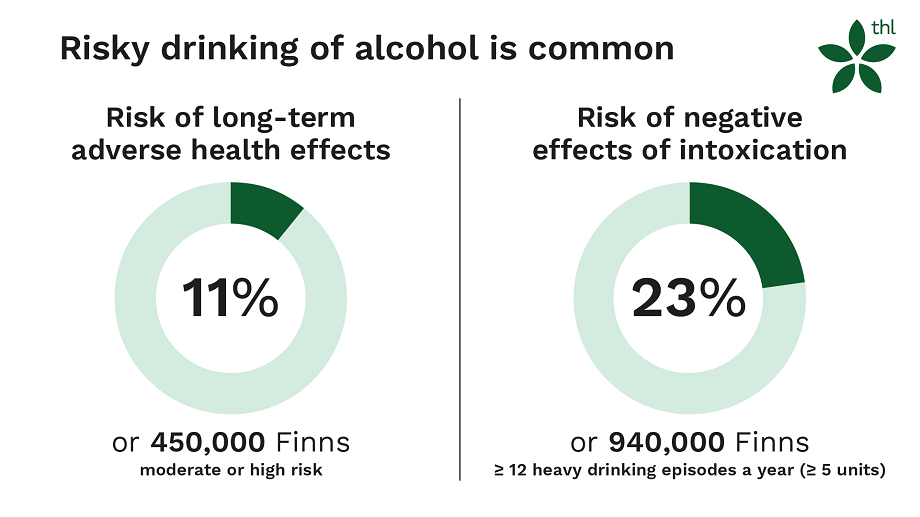High-risk alcohol use is still common, although total consumption has decreased
Although the total consumption of alcohol in Finland has decreased from 2008, risky drinking is still common. Of those aged 20–79, 11% or 450,000 people were in the moderate or high-risk group for long-term alcohol-related harm. The limit for the risks of adverse health effects caused by long-term use is more than 14 units per week for men and more than 7 units for women.
Twenty-three per cent of people aged between 20 and 79 years (about 940,000 persons) drink five units of alcohol in one occasion at least once a month, which exposes them to risks associated with intoxication.

This information is revealed by a report based on the Drinking Habits Survey, for which data was collected in connection with THL’s Healthy Finland health examination survey in 2023.
The prevalence of risky drinking has decreased slightly from the previous Drinking Habits Survey conducted in 2016: at the time, 13 per cent of Finns fell into the group with moderate or high risk of long-term harmful effects and 26 per cent were exposed to risks associated with intoxication once a month or more frequently.
“Although risky drinking and regular use of alcohol have decreased slightly, especially binge drinking is still common. Altogether about three quarters of all alcohol consumed in Finland is consumed either in binge drinking situations or by consumers exceeding the limits of risky drinking,” says Research Professor Pia Mäkelä from THL.
In 2023, men consumed an average of 13 litres of pure alcohol per year, or about 17 units of alcohol per week, while women consumed five litres, or about six units of alcohol per week. Men consumed an average of 4.7 units and women 3.2 units of alcohol per occasion.
Alcohol is most typically drunk at home and during weekends
Negative effects of alcohol also affect other people, not just the person using it. Especially the family and friends are affected. Almost one in three respondents (32%) said that one of their family members or friends had problems due to their own alcohol consumption. This corresponds to approximately 1.35 million Finnish people.
In 2023, three quarters (77%) of the occasions in which alcohol was consumed were in home environments, where also the children are often exposed to the alcohol use of their parents.
Excessive alcohol consumption often increases and exacerbates domestic violence and other problems in close relationships. It was more common for women to experience alcohol-related problems of people close to them than for men. On the other hand, men experienced more harmful effects of their own alcohol consumption than women.
The most serious alcohol-related harm, such as alcohol-related deaths, is more prominent among men and groups lower socio-economic groups.
Alcohol consumption is strongly concentrated at weekends: 68% of all drinking occasions and 79% of binge drinking occasions took place between Friday and Saturday. Between eight and nine in the evening on Saturdays, 16 per cent of Finns aged between 20 and 79, or about 630,000 persons, consumed alcohol.
Alcohol is on average only rarely consumed with food. Six per cent of Finns had wine with a meal on a weekly basis and five per cent had beer. A lot of beer is otherwise consumed in Finland. Up to 45 per cent of the recorded alcohol consumption in 2023 was beer.
“When we look at the drinking habits of Finns, alcohol consumption has not become part of everyday life on a wide scale, which is good from the point of view of preventing alcohol-related diseases. The weekly rhythm of work seems to continue to define the alcohol consumption of Finns, which is concentrated at weekends and evening and night-time hours,” says Senior Researcher Katariina Warpenius from THL.
Responsible alcohol policy is required for the prevention of negative effects
Measures regulating the availability, price and marketing of alcohol have been proven to have a cost-effective impact on the alcohol consumption of the entire population and the prevalence of alcohol-related harm.
Dismantling the retail sale monopoly would have far-reaching impacts on the wellbeing and health of Finnish people. Similarly, online sales and the delivery of alcoholic beverages especially to homes may further increase the consumption of those who use it a lot, which will also be reflected in close relationships.
“The critical question is whether the carrying capacity of the welfare society is sufficient even today for the screening of high-risk alcohol use, brief interventions and, where necessary, referral to treatment. In order to promote the health, welfare and safety of the population in a sustainable manner, responsible alcohol policy in line with the Nordic welfare model is still needed to prevent the harmful effects of alcohol,” Warpenius says.
More information
Pia Mäkelä
Research Professor
tel. +358 29 524 7159
Katariina Warpenius
Senior Researcher
tel. +358 29 524 7019



